
Photo and caption from The Bhils of Alirajpur, with kind permission from Rahul Banerjee and Rohit Jain
An Adivasi man using a mobile phone hung from a post. Mobile networks are scarce in the village of Khodamba as well as in many other villages here. The phones are essential to keep in touch with family members who have migrated to Gujarat for work.
[Editorial note: The Serai team approached Rahul Banerjee in India for an understanding of what has transpired at Bhima Koregaon recently and to provide some perspective of British colonial rule on the west coast of India. Most readers are perhaps unaware of this town in western India and its two-century long history, especially in relation to Adivasis (Indigenous Peoples)* and the Dalit (“untouchables”) movement against the caste system. However, Bhima Koregaon today has evolved into many other things. It has become a lightning rod for discussions in India on civil liberties, the confluence of the rights of Dalits and Indigenous Peoples and the use of preventative detention to control the civil liberties of journalists, writers, poets and others who are opposed to the policies of the present government in India, run by the Bharatiya Janata Party (BJP).
Rahul was able to collect and translate short pieces in Hindi from Shankar Tadwal and Subhadra Khaperde and round them off with comments to create a whole piece in English.
* NOTE: The term Adivasis means original inhabitants or those who were there from the very beginning. There are certain nuances involved in the use of this terminology and in understanding the Dalit-Savarnas angle, which requires further consideration. The article goes a long way in explaining these nuances.]
The Battle of Bhima Koregaon and the Dalit Mahars
The Battle of Bhima Koregaon was the last battle of the Third Anglo-Maratha war on January 1, 1818. The Peshwa of Pune who was on the run with his forces, hotly chased by the British, decided to attack Pune to try and ward off the inevitable defeat. When the advance Peshwa forces neared Pune and were to cross the river Bhima (which had almost run dry at Koregaon village), they met a reinforcement contingent called in by the British to meet the threat of the Peshwa. A battle ensued that was inconclusive because the Peshwa’s troops withdrew after learning of the approach of even greater British reinforcements. About 250 of the Peshwa’s troops were killed, and 50 of the British. Eventually the Peshwa’s forces were subdued and British rule was established in Western and Central India, where the Marathas had ruled earlier.
This battle, although inconsequential at the time, assumed importance later for an entirely different reason. The British erected an obelisk in Koregaon as a memorial for their soldiers who died in the battle. Their names included 22 who were from the Dalit Mahar caste, which was considered untouchable and lowest on the caste hierarchy by the upper-caste Hindus known as the Savarnas.[1] The British used to employ Dalits as soldiers in their armies across India, as part of their policy of subduing the Savarnas. This policy changed after the revolt of 1857 (often referred to as the First Indian War of Independence), as the British thereafter decided to rely on the traditional martial castes considered more reliable.
The Dalit Mahars were obviously opposed to this change, and petitioned the British to renew their recruitment, but to no avail. Then in 1927, a Mahar leader named Ambedkar visited the Koregaon monument and held a big mass meeting, commemorating the Dalit Mahars who had died in the battle as the first martyrs of the battle against the Savarnas. Drawing on the sordid history of the oppression of the Mahars by the Peshwa’s troops, a narrative was created that the battle – instead of being one between the British and the Peshwa – was an assertion of the Dalit Mahars against the Savaranas. Since that time, the Mahars and subsequently all of the Dalits have celebrated January 1st at Bhima Koregaon as a commemoration of the first rising of the Dalits against the Savarnas.
Tribal revolts against the British
While the Dalits, as outcastes of the Hindu social system, saw it to be beneficial to their cause to serve the British as their foot soldiers, the tribespeople who were outside the Hindu social system fought fiercely against the British. From the late eighteenth century in the early years of the British rule, up to the time of independence in 1947, the tribespeople in India rose up in revolt time and time again. In fact, the Bhil people of Khandesh and Nimar in central India fought a dour battle that far outlasted the revolt of 1857 and was only quelled in 1860.
Known as the Great Bhil Rebellion, this seriously jeopardized the north to south route from Agra to Mumbai, which passed through the Bhil homeland. The exploits of Birsa, who led the Munda tribe in revolt, and Sidhu Kanu, who led the Santhal tribe in the nineteenth century, are also legendary. The other large tribe in central India, the Gonds, continually troubled the British through the nineteenth and twentieth centuries, up to the 1930s when the Gudem Rampa rebellion took place in Andhra Pradesh. Tribespeople in the northeast remained restive as well throughout the nineteenth and twentieth centuries, with the Kuki rebellion from 1917 to 1919 viewed as the most serious military challenge to the British since 1857. The main cause of this tremendous opposition among the tribespeople was the encroachment of their forested habitats by the British for the purpose of generating revenue from them in various ways.
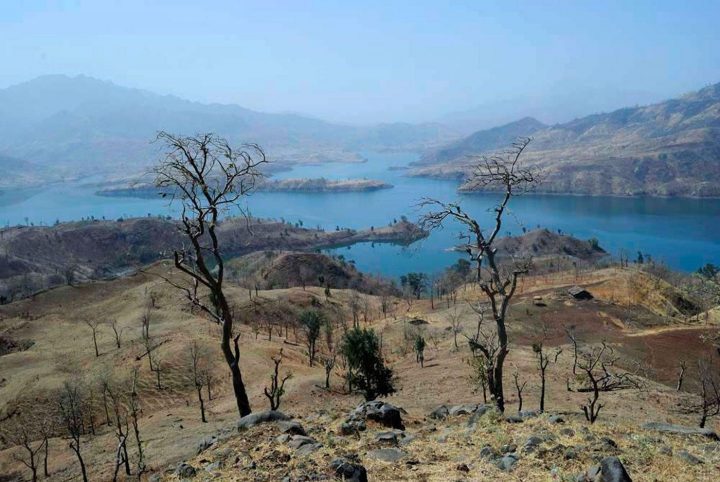
Photo and caption from The Bhils of Alirajpur, with kind permission from Rahul Banerjee and Rohit Jain
The mighty river Narmada across the denuded hills of Alirajpur
The Indian Forest Act and how colonization got legalized
A very harmful law was the Indian Forest Act in 1864. Applying the principle of res nullius, which means that a particular property has no owner if there is no documentary evidence of ownership, the British refused to recognize the customary community rights of the tribespeople over the forests in which they resided, and turned these lands over to the Forest Department created for this purpose. Yet another law that disinherited the Adivasis from their main resource of land was the Land Acquisition Act in 1894. Using the principle of eminent domain, this law empowered the government to dispossess any given private owner of a piece of land for some public purpose, in exchange for a paltry compensation.
Once the British overcame the resistance of the tribespeople, they unleashed the non-tribespeople of Hindu society as traders and farmers into the tribal areas to facilitate their exploitation. The Hindus treated the tribespeople like they treated the Dalits – with disdain and oppression. In many tribal areas in present day Jharkhand, Madhya Pradesh, Odisha, Andhra Pradesh, Maharashtra, Gujarat and Rajasthan, this invasion by non-tribals led to a demographic change, and the tribespeople became minorities in those areas in which they had once been rulers. This combined with loss of their traditional nature-dependent livelihoods adversely affected the lives of the tribespeople. Their traditional nature-centric culture, too, was devastated.
Independence from British rule did not really improve matters for either the Dalits or the tribespeople as a whole. The new constitution did provide for affirmative action in the form of “reservations” in proportion to their population for the Dalits and tribespeople in law-making bodies and government institutions. This provided some access to power and opportunities to a small number of members from these communities. However, the Constituent Assembly that finalized the new constitution was not elected by universal adult suffrage, but was the same as the one formed by the British in 1946 with members from among the elite feudal, capitalist and professional classes, mostly owing allegiance to the former. Ninety-two percent of the members of the Constituent Assemblies were from the Savarna castes.
Thus, they authored a constitution that retained the colonial and anti-people character of the 1935 Government of India Act formulated by the British, greatly discounting the new liberal democratic features such as the provision of fundamental rights and the affirmative sections for the Dalits and tribes. Approximately 250 articles out of 395 in the constitution were taken either verbatim or with minor changes in phraseology from the 1935 Government of India Act, and the basic principles remained unchanged
The independent Indian government in fact continued the policy of the British of promising liberal natural justice on paper and suppressing it in practice, to pursue a policy of extraction of resources to fuel modern industrial development. The British, when introducing the first Government of India Act in 1858, had guaranteed to the people of India inter alia that due regard would be paid to the ancient rights, usages and customs of India when framing new laws, and that these laws would be administered equally and impartially for the benefit of the people.
Almost immediately, however, these principles were breached. The Indian Penal Code was enacted in 1860 and the Code of Criminal Procedure in 1861. These laws, with some minor amendments only, are still in force today and have been codified in such a manner as to provide the administration with a handy means of suppressing organized public dissent. The Indian Forest Act, too, in its 1927 version that effectively converts the tribespeople into trespassers in their own backyard, continues to be in force to this day. The Land Acquisition Act was also retained and widely used to displace people in independent India, particularly the tribespeople, in the pursuit of modern industrial development.
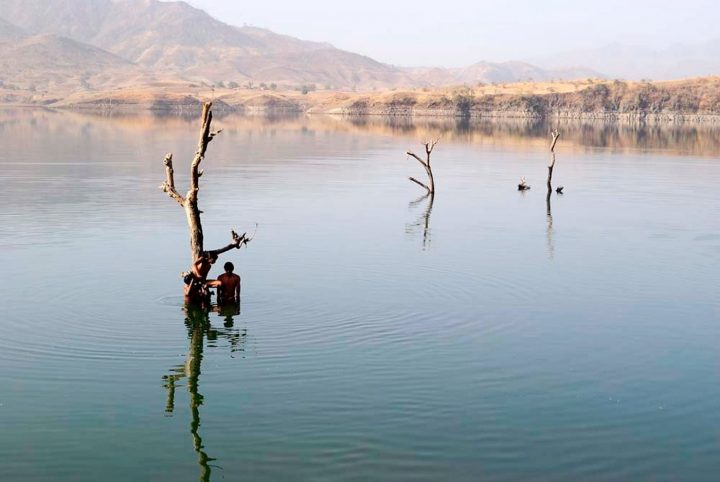
Photo and caption from The Bhils of Alirajpur, with kind permission from Rahul Banerjee and Rohit Jain
Children playing near a tree still standing on their submerged farms in the Sardar Sarovar reservoir
The biggest drawback of all was that grassroots democracy through the establishment of local self-governance was negated. Therefore, although the local self-governance system of Panchayati Raj was included in the Directive Principles of State Policy, these principles were non-justiciable. This meant that, unlike fundamental rights, the traditional rights and conventions of self-administration could not be enforced through the courts. Basic rights, such as for free education, health and nutrition services and the means to a dignified livelihood, were also made non-judiciable. Thus, provisions that could have created a healthy, aware and articulate population and provided people with an institutional structure for implementing their development according to their own genius and so curtail the power of the ruling classes were ignored totally by the governments, both at the centre and in the states after independence.
This paved the way for the persistence of a form of internal colonialism and feudalism. Matters were compounded by the fact that fundamental rights were not easily assured either, given the tremendous expenses involved in approaching the high courts and the Supreme Court for redress. While the erstwhile princes, landlords and the capitalists often went to court to obstruct the path of justice for the poor, the latter, especially the Dalits and tribespeople, could hardly afford to do so and thus had to bear with the illegal actions of the ruling classes enacted directly or through the organs of the state.
This in effect meant that the checks and balances forming a basic part of a liberal democratic set-up were disturbed in favour of the executive, consisting of the council of ministers and the bureaucracy. The party system ensured that the council of ministers and its leader, the prime minister, would always be much more powerful than their fellow legislators. Moreover, the “first past the post” electoral system ensured that the Indian National Congress, despite garnering only around 40 percent of the votes cast, got more than 75 percent of the seats in the law-making bodies.
In the initial years after independence, this overwhelming majority of the Congress party and the charisma of its leader, Nehru, meant that the opposition was not very vocal or effective in monitoring the actions of the government. Parliament was reduced to being as ineffectual as a debating society. Moreover, preventive detention laws were enacted to silence the protests of people’s organizations and their leaders outside parliament, and thousands of such people were jailed. To make matters worse, the press was not so combative or investigative and did not have much of a reach, given the high level of illiteracy.
Thus the government and the bureaucracy rode roughshod over democratic niceties to push through a process of modernization at the cost of the ordinary people, by using colonial repressive laws and by flouting the progressive aspects of the constitution. The bureaucracy, which continued in its colonial mindset, was a power unto itself, as it not only framed all the laws but also interpreted and administered them to the detriment of an illiterate and unaware populace. The Dalits and tribespeople, situated as they were at the bottom of Indian society, suffered the most from this oppressive and repressive dispensation.
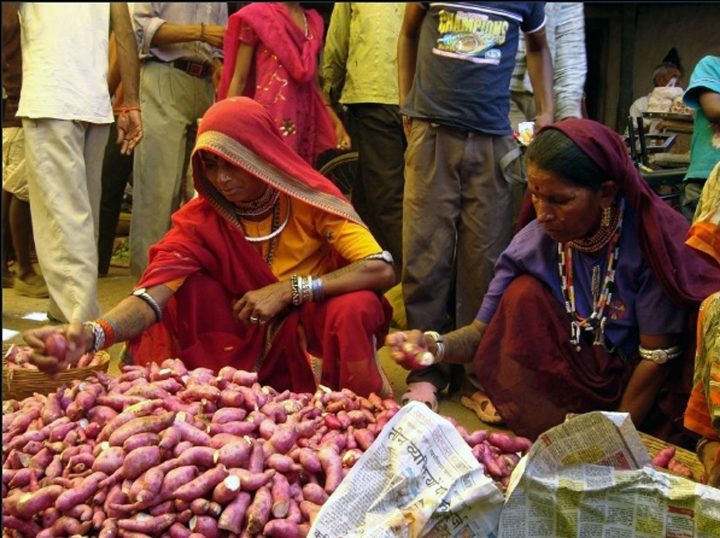
Photo and caption from The Bhils of Alirajpur, with kind permission from Rahul Banerjee and Rohit Jain
Women selling sweet potatoes grown on their farms at the haat (weekly market) in Valpur village in Alirajpur. The Adivasis sell a considerable amount of local produce in these haats, including jowar, bajra, maize, sesame, groundnut, onions and potatoes. They also buy some of their household and farm items here, such as salt, sugar, cooking oil, soap, ploughs and axes.
Why did this happen?
It was because of Brahminism. This has been defined by the Dalits as the ideology of caste oppression codified by the Hindu Brahmin law-giver, Manu. It has been foisted by the minority 7% elite of Savarna castes on the rest of the toiling castes who identify themselves as Bahujans, including the so-called “other backward classes” (OBCs), Dalits, and tribespeople, who together constitute 75 percent of the population. The Muslims constitute 16 percent of the population, and the followers of other religions comprise the remaining 2 percent; they too, except for a few elites among them, suffer from the adverse effects of Brahminism, which has been internalized by them.
Consequently, the history of India since independence has been one of constant mass mobilization by the Bahujans against Brahminism and oppression by the Savarnas.
The acceptance by the Government of the Mandal Commission Report in 1990 brought about a major new counterthrust from the Savarnas, now solidified in a rule by an openly Brahminical party. The so-called “Socially and Educationally Backward Classes Commission” headed by B P Mandal was constituted by the Government to consider whether affirmative reservations could be extended to OBCs. It had recommended in its report published in 1980 that, in addition to the Dalits and tribespeople, the “other backward classes” should also be provided reservations in government jobs and educational institutions. The government of the then Prime Minister V P Singh implemented the Mandal Commission Report, immediately arousing a huge mass backlash from the Savarnas, who resorted to arson and violence on the streets.
The Bharatiya Janata Party (BJP) seized this opportunity to begin its mass mobilization for the construction of the Ram Temple (at the site of the Babri Masjid mosque in Ayodhya) as a stepping stone to the establishment of a majoritarian Hindu state, which has for long been the aim of its ideological parent, the Rashtriya Swayamsevak Sangh (RSS). A long march across the country was launched by the BJP under the leadership of its leader L K Advani, which ultimately led to the demolition of the Babri Masjid on December 6, 1992, by a mob assembled by the BJP. The BJP has bolstered its strength since then by uniting a section of the OBCs and Dalits with the Savarnas and co-opting the former into the Brahminical project of creating a Hindu majoritarian state. As was the case with the Congress earlier, the national and international capitalist class and the media are solidly behind the BJP.
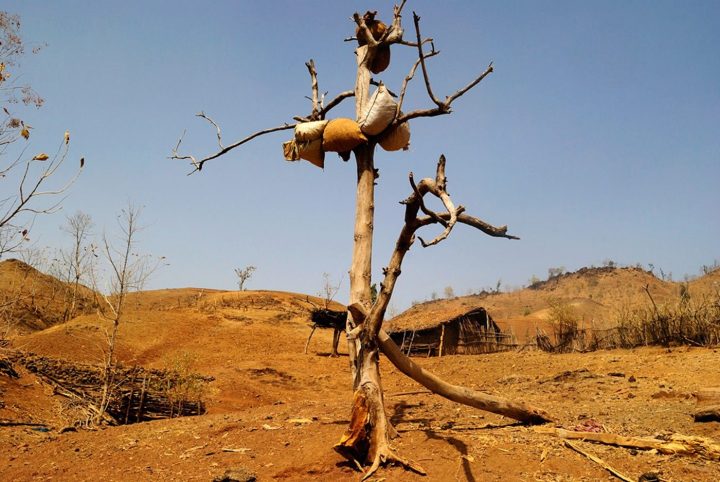
Photo and caption from The Bhils of Alirajpur, with kind permission from Rahul Banerjee and Rohit Jain
The Adivasis save the seeds from the current crop in sacks on a tree. They use the seeds for sowing the following year and usually don’t buy any from the market.
Right from the time of independence, there has been considerable discontent and unrest among the popular masses, especially the Dalits and tribespeople, protesting their oppression and the devastation of their livelihoods. From the late 1960s, in tandem with protests elsewhere in the world, student unrest also added to these protests, which became more widespread. Most of this discontent has been expressed through mass protests on the streets and through the formation of political parties by oppressed sections of the population, to try and get power through the ballot. However, there have also been armed insurrectionary movements to either overthrow the capitalist state or secede from it. The former armed movements are in the tribal heartland in Central India; the latter are in the tribal areas of the northeast, which of course date from the time of independence itself. There is also the armed movement of the Kashmiris for independence.
To counter these armed movements, the Indian state has at times enacted draconian laws that violate the principles of human rights and civil liberties. The legitimacy for these draconian laws is derived from resolutions passed from time to time by the United Nations Security Council, for the suppression of terrorism. Currently, the most draconian one frequently used is the Unlawful Activities Prevention Act,[2] which was initially enacted in 1967 but has been amended since – in 2004, 2008, 2013 and most recently 2019 – making it one of the most violative of the United Nations Universal Charter of Human Rights.

Photo and caption from The Bhils of Alirajpur, with kind permission from Rahul Banerjee and Rohit Jain
An Adivasi farmer in Attha standing amidst his resplendent crop of bajra. The productivity of the kharif crop here, grown only using cattle manure, is quite high. But the landholding is so small that the total produce is not enough to feed everyone in the village.
Back to Bhima Koregaon
The bicentenary of the Bhima Koregaon battle fell on January 1, 2018. Dalits from all over the country congregated in huge numbers, and some two hundred thousand people attended the commemoration ceremony at Bhima Koregaon. When returning from the event, the Dalits were set upon with stones by members of two Hindu majoritarian organizations, leading to the death of one Dalit youth and injuries to others. There were massive protests by Dalits after this in various cities of Maharashtra, which was then ruled by a BJP Government.
Afterwards the police began an investigation into this violence, and instead of indicting the Hindu majoritarian organizations and their leaders who had done the stone pelting, they came up with another story altogether. They said that the underground organizations conducting the armed movements against the state in the central Indian region had conspired to cause the violence and claimed that this was part of a larger conspiracy to assassinate the Prime Minister of the country, who was heading the BJP Government at the Centre.
Subsequently, on the basis of emails found by the police, many people have been implicated under the Unlawful Activities Prevention Act as supporters of the organization engaged in armed movements in the tribal regions of Central India who were providing them with legal and communication support. The police have clamped them into prison alongside thousands of others, most of whom are tribespeople who have been accused of conducting armed movements from the central Indian and northeastern regions.
Thus, Brahminism, which has been ascendant in India from ancient times, was not only instrumental in the oppression of Dalits and tribespeople in British times – it has continued to rule this country after independence and is now openly dominating it through a Hindu majoritarian party whose goal is to establish a Hindu State. However, the mass organizations of the Dalits and tribespeople across the country are fighting this diabolical plan of the BJP and the RSS with all their might, and have not been subdued by the use of the Unlawful Activities Prevention Act and other draconian laws designed to crush them.
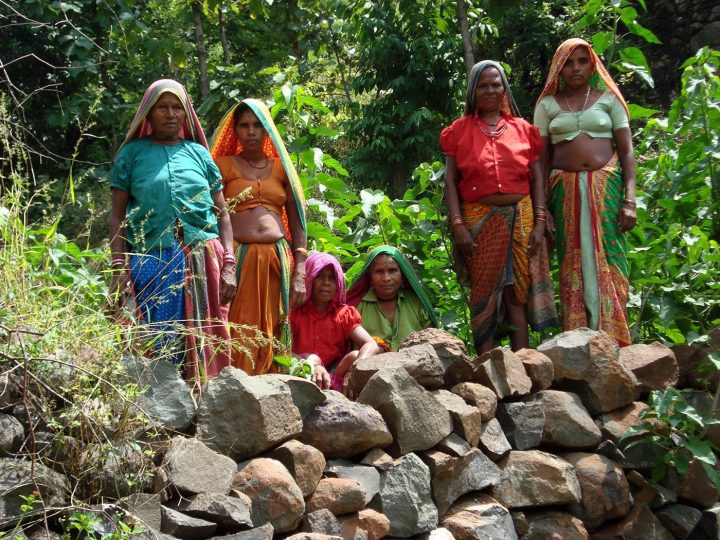
Photo and caption from The Bhils of Alirajpur, with kind permission from Rahul Banerjee and Rohit Jain
The women of Attha village are working together to repair a farm bund made of stones. The Bhils pool labour – they work on each other’s farms to save on monetary wages. This custom is called “dhas.”
[1] Savarnas: The Hindu caste system in India evolved from the second millennium before the Christian era. A few Savarnas involved in religious, intellectual, military and trading pursuits began relegating the vast majority of the population, known as Shudras, to do the physical work as farmers and artisans. Some of them were labelled outcastes, relegated to do the menial work of skinning animals and cleaning toilets. The Adivasis were driven out of the plains and continued with their subsistence lives in the forested hilly areas outside the Hindu caste system.
[2] The main provisions of the Unlawful Activities Prevention Act are as follows:
- 1. Organizations and Individuals can be notified as unlawful and terrorist and their names put in a schedule, and any persons associated with them are culpable. Even corresponding with them is an offence. If the names of persons are mentioned in the correspondence of these organizations and individuals, then they too become culpable.
- Apart from such activities as counterfeiting, bombing, murdering, etc., which are patently terrorist acts, even rioting and “inciting and spreading violence, enmity and religious disharmony” are considered to be unlawful activities.
- Anticipatory bail is not available to the accused.
- The quality of evidence required to incriminate people is not required to be of a high standard, even though it may not stand scrutiny during trial. Such evidence is considered prima facie to be sufficient to arrest people and deny them bail.







